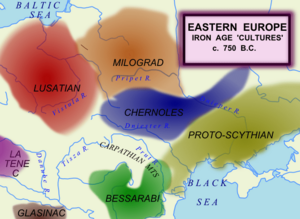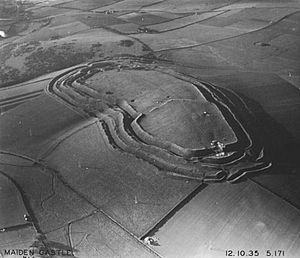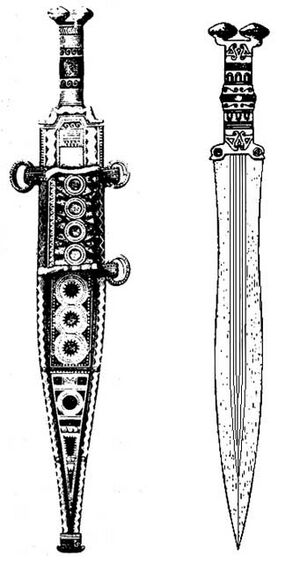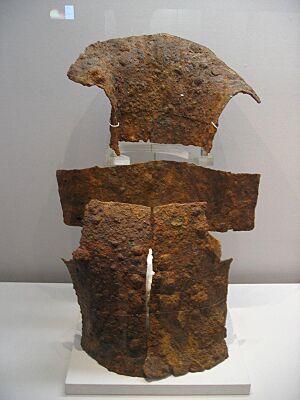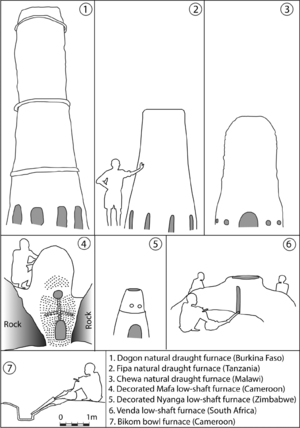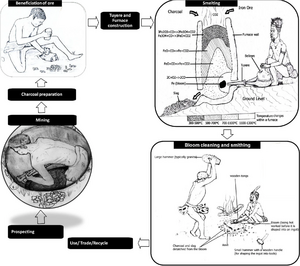Iron Age facts for kids
The Iron Age was a very important time in human history, roughly from 1200 BC to 550 BC. It's the last part of what historians call the "Metal Ages," coming after the Copper Age and the Bronze Age. Before these metal ages, people lived in the Stone Age. During the Iron Age, people learned to make tools and weapons from iron, especially steel, which was much stronger and lighter than bronze. This change was a big deal for how people lived, worked, and even fought!
The Iron Age didn't start everywhere at the same time. In places like Anatolia (modern-day Turkey) and parts of Europe, it began around 1300 BC. In the ancient Near East, it started around 1200 BC, which was also when the Late Bronze Age collapse happened. From there, iron technology slowly spread across the Mediterranean basin and into South Asia. It took a bit longer to reach Central Asia, Eastern Europe, and Central Europe, and didn't get to Northern Europe until about 500 BC.
Interestingly, some parts of the world, like much of Africa, didn't have a "Bronze Age" at all. They went straight from using stone tools to using iron. Some experts even think that people in sub-Saharan Africa might have discovered how to make iron on their own, as early as 2000 BC! In other places, like China, written history began before iron was widely used, so the term "Iron Age" isn't always used in the same way there. The Iron Age usually ended when written records became common, or when big empires like the Roman Empire took over. For example, in Scandinavia, the Iron Age ended around 800 AD, when the Viking Age began.
How We Talk About the Iron Age
Have you ever wondered how historians and archaeologists organize the past? They use a system called the three-age system. This system divides early human history into the Stone Age, the Bronze Age, and the Iron Age. This idea first became popular in Europe in the early 1800s. Later, it was also used to describe the history of the ancient Near East.
A Danish expert named Christian Jürgensen Thomsen first used this system for Scandinavia in the 1830s. People quickly realized it was a great way to understand the "earliest history of mankind." By the 1920s and 1930s, this way of dividing history became standard for studying ancient times.
What Makes Iron Special?

Before people learned to make iron from rocks, they sometimes found "meteoric iron" that fell from space! This natural iron-nickel mix was used for special items thousands of years before the Iron Age. For example, some small beads made from meteoric iron were found in Egypt, dating back to 3200 BC. People carefully hammered these pieces into shape.
The real start of the Iron Age was when people learned to make iron themselves. This meant taking iron ore (rocks with iron in them) and heating them up to very high temperatures. They learned to add carbon to the iron, creating steel. Steel was amazing because it was much harder and lighter than bronze, making better tools and weapons.
Making iron was tricky! Iron is very common in the Earth, but it needs temperatures above 1250°C (about 2282°F) to melt. This was much hotter than what people could easily achieve during the Bronze Age. Bronze, made from tin and copper, melts at lower temperatures that were possible with older ovens. To make good iron, ancient metalworkers also had to figure out how to remove unwanted stuff from the iron and how to work with it while it was hot to make it strong.
When Did the Iron Age Begin?
 |
Early Discoveries of Iron
Scientists have found some of the earliest signs of iron-making in Turkey, dating back to 2200–2000 BC. These were small pieces of iron with carbon mixed in, suggesting that people were already trying to make steel. Around 1800 BC, iron tools were used by important people in this region, but they weren't common for everyone yet.
Similar discoveries show that ironworking might have started in India's Ganges Valley around 1800 BC. This means people in different parts of the world were figuring out how to work with iron. By the Middle Bronze Age, more and more iron objects appeared in the Middle East, Southeast Asia, and South Asia.
In Africa, some sites show ironworking as early as 2000–1200 BC. Some studies even suggest it began between 3000 and 2500 BC in places like Nigeria and Cameroon. This suggests that people in sub-Saharan Africa might have invented iron smelting on their own! For example, the Nok culture in Nigeria might have started smelting iron by 1000 BC.
The Official Start of the Iron Age
Even though meteoric iron was used for a long time, the Iron Age truly began when people started making iron tools and weapons on a large scale. This new technology replaced bronze tools in everyday use.
Archaeologists generally agree that large-scale iron production began around 1200 BC. This time also marks the end of the Bronze Age. In Europe, the Iron Age is often linked to the Bronze Age collapse in the ancient Near East.
One idea is that around 1300 BC, there was a shortage of tin, which is needed to make bronze. This forced metalworkers to find a new material. Iron became a great alternative because it was cheaper, stronger, and lighter once they learned how to work with it.
In Central and Western Europe, the Iron Age lasted from about 800 BC to 1 BC. In Northern Europe, it started later, around 600 BC, and reached Scandinavia by 500 BC. For the ancient Near East, the Iron Age is thought to have ended around 550 BC, when the Achaemenid Empire began.
In China, writing developed very early. So, the "Iron Age" there is sometimes used for a period from about 900 BC to 100 BC, when iron was present but not yet the main metal.

The Iron Age Around the World
Ancient Near East
The Iron Age in the ancient Near East likely started around 1300 BC. This was after people in places like Anatolia (Turkey), the Caucasus, or Southeast Europe learned how to smelt and shape iron. One of the earliest places where iron was smelted on a larger scale was at Tell Hammeh in Jordan, around 930 BC.
In the Caucasus region, the Early Iron Age is split into two parts: Early Iron I (around 1100 BC) and Early Iron II (10th–9th centuries BC). Many traditions from the Late Bronze Age continued into this new iron period. In Iran, the first real iron objects appeared around the 9th century BC.
West Asia
In ancient lands like Sumer, Akkad, and Assyria (parts of modern-day Iraq), iron was used as early as 3000 BC. One of the oldest iron daggers was found in a tomb in Anatolia, dating back to 2500 BC. By the early 1000s BC, iron weapons quickly became common across the Near East.
People once thought that the Hittites of Anatolia had a secret "monopoly" on ironworking. They believed this helped the Hittite Empire become powerful. However, experts now know that while some iron objects were found in Bronze Age Anatolia, similar items were also found in Egypt and other places. It seems ironworking spread more slowly and wasn't a secret held by just one group.
| Date | Crete | Aegean | Greece | Cyprus | Sub-totals | Anatolia | Totals |
|---|---|---|---|---|---|---|---|
| 1300–1200 BC | 5 | 2 | 9 | 0 | 16 | 33 | 49 |
| Total Bronze Age | 5 | 2 | 9 | 0 | 16 | 33 | 49 |
| 1200–1100 BC | 1 | 2 | 8 | 26 | 37 | N/A | 37 |
| 1100–1000 BC | 13 | 3 | 31 | 33 | 80 | N/A | 80 |
| 1000–900 BC | 37+ | 30 | 115 | 29 | 211 | N/A | 211 |
| Total Iron Age | 51 | 35 | 163 | 88 | 328 | N/A | 328 |

Dates are approximate
- Prehistoric (or proto-historic) Iron Age Historic Iron Age
Egypt
Iron objects are quite rare in ancient Egyptian collections. Bronze remained the main material there until the Assyrians conquered Egypt in 671 BC. This might be because ancient Egyptians thought iron was an "impure" metal. They didn't use it for religious items or things placed in tombs. They even linked it to Seth, a god associated with evil.
However, some iron has been found. In the Black Pyramid of Abusir, dating before 2000 BC, some iron pieces were discovered. A dagger with an iron blade was found in Tutankhamun's tomb (13th century BC). Recent studies showed this dagger was made from meteoric iron, meaning it came from space!
Europe
In Europe, the Iron Age is the last part of prehistoric Europe. It's also the first of the "protohistoric" periods, which means Greek and Roman writers started describing these areas. For much of Europe, the Iron Age ended when the Romans conquered them. However, ironworking continued to be the main technology for a long time after that.
Ironworking came to Europe in the late 11th century BC, probably from the Caucasus region. It slowly spread north and west over the next 500 years. The Iron Age didn't start just when iron first appeared. It began when iron started to replace bronze for making tools and weapons. This happened at different times across Europe. For example, the Iron Age in Prehistoric Ireland started around 500 BC and ended around 400 AD.
The prehistoric Iron Age in Central Europe is divided into two main cultures: the Hallstatt culture (early Iron Age) and the La Tène culture (late Iron Age). These cultures are further divided into four phases (A, B, C, D).
| Culture | Phase A | Phase B | Phase C | Phase D |
|---|---|---|---|---|
| Hallstatt | 1200–700 BC Flat graves |
1200–700 BC Pottery made of polychrome |
700–600 BC Heavy iron and bronze swords |
600–475 BC Dagger swords, brooches, and ring ornaments, girdle mounts |
| La Tène | 450–390 BC S-shaped, spiral and round designs |
390–300 BC Iron swords, heavy knives, lanceheads |
300–100 BC Iron chains, iron swords, belts, heavy spearheads |
100–15 BC Iron reaping-hooks, saws, scythes and hammers |
Iron Age Europe is known for its fancy designs on weapons, tools, and dishes. These items were hammered into shape, not cast, and often had detailed, curvy decorations.
Citânia de Briteiros in Portugal is a great example of an Iron Age archaeological site. This fortified village was a stronghold against Roman invasions and dates back over 2500 years. Archaeologists found many items there, including containers for wine or olive oil, coins, pottery pieces, weapons, and jewelry. They also found the ruins of a bathhouse.
Asia
Central Asia
The Iron Age in Central Asia began with the Saka people, who lived in what is now Xinjiang. This happened between the 10th and 7th centuries BC, with evidence found at sites like the Chawuhukou cemetery.
The Pazyryk culture is another important Iron Age culture (around 6th–3rd centuries BC). We know about them from amazing artifacts and mummified people found in the frozen ground of the Altai Mountains in Siberia.
East Asia

Dates are approximate
- Prehistoric (or proto-historic) Iron Age Historic Iron Age
In China, writing on bronze objects appeared around 1200 BC, even before ironworking became common. Iron metallurgy was known by the 9th century BC. It reached the Yangtze valley in the late 6th century BC. Iron tools were found in tombs from the 4th century BC.
The techniques used in southern China combined local traditions with methods from central China. This led to the creation of bells, vessels, weapons, and ornaments.
An Iron Age culture on the Tibetan Plateau is thought to be connected to the Zhangzhung culture, mentioned in old Tibetan writings.
In Japan, iron tools, weapons, and decorations likely arrived during the late Yayoi period (around 300 BC to 300 AD) or the following Kofun period (around 250–538 AD). These items probably came from the Korean Peninsula and China.
The Yayoi period is known for new pottery styles and the start of widespread rice farming in paddy fields. The Kofun period is named after the large burial mounds (called kofun) from that time.
Iron objects came to the Korean peninsula through trade around the 4th century BC. Iron production quickly followed in the 2nd century BC, and farmers in southern Korea were using iron tools by the 1st century BC. The earliest cast-iron axes in southern Korea were found in the Geum River basin.
This period, when iron production began, is also when complex chiefdoms (groups led by powerful chiefs) started to appear in Korea. These chiefdoms later grew into early states like Silla, Baekje, Goguryeo, and Gaya. Iron bars were important items buried with the dead, showing the wealth or status of the person.
South Asia

Dates are approximate
- Prehistoric (or proto-historic) Iron Age Historic Iron Age
Early signs of iron smelting in India appeared centuries before the main Iron Age. For example, iron was used to make small items in Mundigak as early as the 3rd millennium BC. Small knives and blades found in the Indian state of Telangana date back to 2400 and 1800 BC.
Archaeological sites in India, like Malhar and Lahuradewa, show iron tools from 1800–1200 BC. The site of Malhar, located near the Karamnasa and Ganga Rivers, seems to have been a center for making iron. This site shows agricultural tools like sickles and nails, as well as spearheads, by about 1500 BC.
By the early 1st millennium BC, iron metallurgy in India had advanced greatly. People became very skilled at working with iron. In Southern India (modern-day Mysore), iron appeared as early as the 12th to 11th centuries BC. The Indian Upanishads, ancient texts, even mention metalworking. By 300 BC, and certainly by 200 AD, high-quality steel was being made in southern India using a special "crucible technique."
In Sri Lanka, the early Iron Age lasted from 1000 BC to 600 BC. Evidence from sites like Anuradhapura shows that settlements grew into towns during this time. The remains of an Early Iron Age chief were found in Anaikoddai, Jaffna.
The oldest clear written records in India are the Edicts of Ashoka from the 3rd century BC. These were written in the Brahmi script.
Southeast Asia

Dates are approximate
- Prehistoric (or proto-historic) Iron Age Historic Iron Age
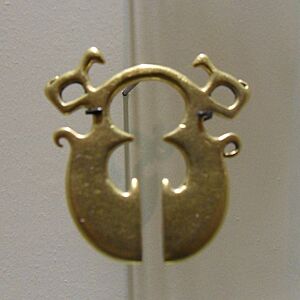
In Thailand, archaeological sites like Ban Don Ta Phet and Khao Sam Kaeo show metal, stone, and glass objects. These items, similar to those from India, suggest that Indian culture started influencing Southeast Asia between the 4th and 2nd centuries BC, during the late Iron Age.
In the Philippines and Vietnam, the Sa Huynh culture had a wide trading network. Their beads were made from materials like glass, carnelian, and gold, which were not found locally. This means they were imported. Bronze mirrors from the Han dynasty in China were also found at Sa Huynh sites. In return, Sa Huynh ear ornaments have been found in Thailand and on Orchid Island.
Africa
Early evidence for iron technology in Sub-Saharan Africa comes from sites in northwest Tanzania, Nigeria, and the Central African Republic. Nubia was one of the few places in Africa that had a long Bronze Age, similar to Egypt.
Iron metallurgy started in many different parts of Africa. These origins were in West Africa, Central Africa, and East Africa, showing that these were truly African inventions. Ironworking developed in Nigeria around 2631–2458 BC, in the Central African Republic around 2136–1921 BC, and in Niger around 1895–1370 BC.
Very early copper and bronze working sites in Niger might date back to 1500 BC. There's also evidence of iron metallurgy in Termit, Niger, from around the same time. Nubia became a major producer and exporter of iron after the Assyrians drove the Nubian dynasty out of Egypt in the 7th century BC.
Some archaeologists believe that iron metallurgy developed independently in sub-Saharan West Africa, meaning it wasn't copied from Eurasia or nearby parts of North Africa.
Sites in the Nsukka region of southeast Nigeria have revealed iron smelting furnaces and slag (waste from smelting). These date to 2000 BC at Lejja and 750 BC at Opi. The site of Gbabiri in the Central African Republic shows evidence of iron metallurgy from around 896–773 BC. Similarly, smelting in bloomery furnaces (a type of furnace) appeared in the Nok culture of central Nigeria by about 550 BC, and possibly even earlier.
Iron and copper working spread south and east from Central Africa, along with the Bantu expansion. This movement went from the Cameroon region to the African Great Lakes in the 3rd century BC, reaching the southern tip of Africa around 400 AD. Some evidence suggests ironworking might have been practiced in central Africa as early as the 3rd millennium BC. Also, carbon steel was being produced in northwest Tanzania around the 1st century AD, using advanced heating methods.

Dates are approximate
- Prehistoric (or proto-historic) Iron Age Historic Iron Age
See also
 In Spanish: Edad del Hierro para niños
In Spanish: Edad del Hierro para niños
- Blast furnace
- Fogou
- Jublains archeological site, example in northwest France
- List of Iron Age states
- List of archaeological periods
- List of archaeological sites by country
- Metallurgy in pre-Columbian America
- Roman metallurgy


